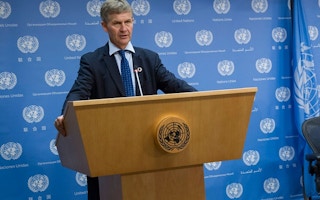People are hungry for news about the risks of climate change but experts are alienating them with boring, technical jargon, the United Nations top environment official said on Tuesday.
Erik Solheim, executive director of the United Nations Environment Programme (UNEP), said one of the most searched terms on the Internet this year was “Hurricane Irma”, a powerful storm that devastated parts of the Caribbean.
“It shows people want to know about these things but when it comes to explaining why it’s happening and what can be done to stop it, we’re not speaking in language that everyone understands,” he told the Thomson Reuters Foundation.
“The language of environmentalists has been boring, so uninspiring … If we just speak a technical language, with many acronyms and politically-correct phrases, no one will listen,” he said in an interview during a conference on landscapes in Bonn.
“You cannot bore people into action. They need to be excited and inspired to take action and change their behaviour.”
As public attention is focused on big disasters that make the headlines, important issues like loss of forests and land degradation risk being left behind, the former Norwegian international development and environment minister said.
“
More than 1.3 billion people live on agricultural land that is deteriorating and face worsening hunger, water shortages and poverty.
A third of the planet’s land is severely degraded - which can happen through deforestation, overgrazing and drought - forcing people to migrate and increasing the risk of conflict over dwindling resources, it said.
“That’s a big problem we need to address urgently,” said Solheim, adding that funding to combat climate change needs to be broadened to include rebuilding degraded land.
Research shows that restoring degraded land generates an estimated $7 to $30 in economic benefits for every dollar invested, but funding for landscape restoration fall short by $300 billion a year.
Only 3 per cent of climate finance is allocated to restoring land and forests, even though research has shown it has great potential to help meet an international pledge to hold global warming to a 2-degree Celsius temperature rise, Solheim said.
“We need to find ways to change that - and one way is to use the transformative power of the financial system,” he said.
UNEP announced a partnership with French bank BNP Paribas last week to channel $10 billion in funding to smallholder farmers in developing countries by 2025 to help boost their incomes and protect forests and land.
This story was published with permission from Thomson Reuters Foundation, the charitable arm of Thomson Reuters, which covers humanitarian news, women’s rights, trafficking, property rights and climate change. Visit news.trust.org. Read the full story.

















